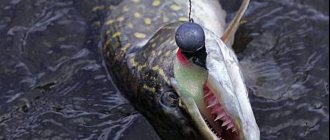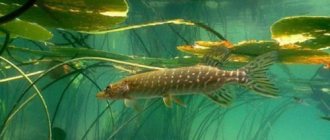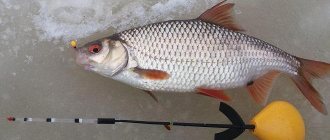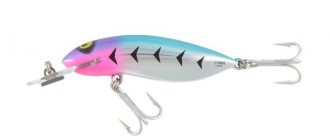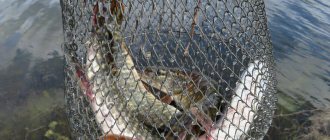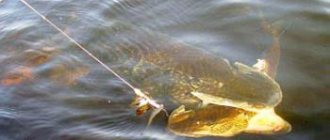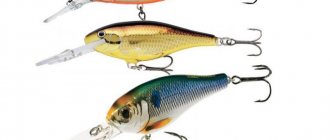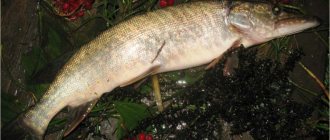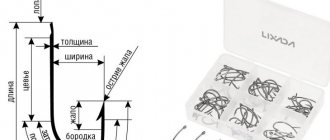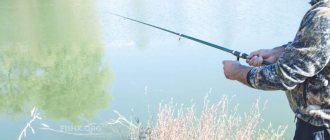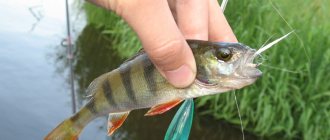Fishing is the best leisure time for half of the male population of the planet. The most coveted trophy has always been and is pike. If you carry out the right preparation and choose the right place to fish, a rich catch is guaranteed. Lately, a large number of new fishing gear have been appearing on sale. All kinds of oscillating spinners are especially popular. For pike, these are the most successful baits. They very realistically imitate the movements of the fry, causing hunting excitement in the toothy predators.
The pike spinner is an effective bait that has been used by amateur fishermen for decades. Experience shows that this equipment on a spinning rod allows you to get real pleasure from the fishing process. Now stores offer a large selection of silicone and plastic wobblers, but spinners remain the most popular bait.
The design of the movable spoon looks like a metal mold with holes at the top and bottom. A hook is attached to one hole, and a winding ring to the other. To prevent the fishing line from getting tangled or deformed, install a swivel (a rotating element with ears). The material for the manufacture of vibrators is a metal alloy (copper, lead, steel). Lures are produced in various shapes, and they are also painted with bright or shiny colors.
How to choose a spoon for pike
Pike always tries to hide in the coastal zone of a river or lake.
There is a list of recommendations on how to choose the right spoon for pike, based on many years of experience among fishing enthusiasts:
- When the weather is cloudy, it is worth using baits of acidic colors; on a sunny day it is better to attach dark or dull baits. The main thing is contrast, then the spoon is most noticeable and attractive in the water column.
- Vibrators with a shiny surface are most effective. However, they should be used with caution; bright glare in the sun will scare away fish. Black spoons work well in clean, clear water. They do not irritate the fish; on the contrary, they activate the bite.
- Red or white baits are often used. Here you also need to take into account the presence of currents, vegetation, weather, and other features.
- For large specimens of fish, it is advisable to purchase large oscillating baits. Small spinners will not give the expected effect. The optimal length of an artificial fish is 12-15 centimeters. Wide, flattened imitations are ideal. Lures with a large bend make sudden movements in the water, which scare away underwater inhabitants.
- In spring it is better to use medium-sized spinners, and in autumn - large ones. This is explained by the large appetite of toothy beauties before hibernation.
- At great depths, it is recommended to install heavy spoons so that they can sink freely into the water. Light equipment is suitable for surface fishing. The weight of fishing products depends on the metal alloy.
If you stick to these observations, you can always get a good catch. Although each fisherman has his own notes that help him catch the desired trophy.
Weight of spinners and their game
But even a spoon of the same thickness can be stamped from a conventionally “light” or “heavy” metal, which also affects the performance of the spoon. Homemakers usually stamp their spinners from solid brass, followed by electroplating or passivation. Such spinners are easier to process: grind off burrs, round corners, countersink holes, change shape... To save money, factory spinners are usually stamped from a “layered” sheet, where “noble” thin metal sheets on top and bottom are soldered together with a thick layer of cheap alloy. After galvanization, it is much more difficult to modify such factory spinners.
Rods for fishing with spoons
For heavy predatory fish, they usually take a spinning rod, the correct choice of which is based on the determination of: test, length, action. The characteristics of a rod for fishing pike with spoons must correspond to the conditions of use of the gear. The length of the reach of the rod on which the spoon is attached depends on the openness of the area. If there are no obstacles for casting, then use a fishing rod from 2.7 to 2.8 meters.
According to the test, a spinning rod is selected according to the weight of the equipment that is supposed to be installed for fishing. The main thing here is the sensitivity of the gear, since a mismatch in the ratios will disrupt the performance. It is ideal to use the M-medium (medium) test for pike - 10-30 grams. In order not to damage the tackle, it is recommended to choose a test that is 1/3 more than the weight of the oscillating spoon.
For predatory fish, you should choose medium action gear (indicates the rigidity of the fishing rod). It will allow you to easily cast the spoon over long distances. This is possible because the casting qualities are many times superior to fast action fishing rods. When casting, 1/2 of the fishing rod is used, and not 1/3 of the gear. When fishing for pike using spinners, it is worth installing spinning reels.
Oscillating spoon equipment
To make the bait more attractive to predators and more suitable for fishing in difficult conditions, it should be slightly modified. The first and simplest thing is to attach a bunch of bright red threads to the tee of the vibrator. It is believed that red color, or any other bright color, is a strong irritant for pike. True, more often a tee with a red edge is used on “spinners”, but such a modernization is also of interest for oscillating spinners for pike fishing.
Catching pike with a spoon is most often carried out at shallow depths, and a slowly gliding spoon is much more attractive to the predator.
The next step is to reduce the mass of the oscillating spoon, since fishing is carried out at shallow depths and a slowly gliding bait is more attractive to a predator.
Read! Pike fishing in April
You can significantly modify the game of the oscillating spoon by installing a smaller hook and made of thinner wire. You can also change the winding rings to lighter ones - on most “oscillators” the rings are very large. These modifications give the opposite effect to what is obtained when replacing a conventional tee with a tee with an “edge”. In this case, the working amplitude of the spinner's oscillations increases. It is useful to try both options, because it is difficult to say in advance which one will be more attractive to pike.
Do you need a tee?
A more radical way to modernize an oscillating spoon involves replacing the tee with an offset or double hook with a silicone bait. It would seem that there is nothing complicated: I changed it, hung up the rubber, the spinner became more passable, the number of hooks decreased - everything is great. But this is where many problems arose, the most important of which was the sudden change in the game. Often (in about every second or third case) the spinner either goes into a tailspin or simply turns off from the game.
To avoid such problems, you need to know a few rules. The first and most important thing is the size of the offset hook, the total length of which should be about one and a half, or even two times less than the size of the spoon itself. The same applies to the size of the silicone bait - the performance of the spinner depends no less on this.
The play of an oscillating spoon in a design with an offset hook and “rubber” should be snake-like, that is, describe a sinusoid in the water. Having achieved such a game, we get the most catchable bait. Pike really like this kind of spinner action, especially in the fall.
As for the color of “rubber,” shades of green or brown work best; purple often helps out. But there are exceptions when bright acidic colors (lemon, orange, red) work just as well.
Read! Catching ide with a spinning rod
You can connect the body of the spinner to the hook not with one winding ring, but with a sequence of two or three, thereby achieving a greater degree of freedom for the entire structure. This option often becomes successful.
Techniques and tactics of fishing with spoons
The technique of fishing with a spoon is that the pike reacts to the slow, smooth movement of the bait in the water. The slowness of the victim provokes the toothy individual to attack. The wiring can be done so that the spoon barely touches the bottom, drags, and raises the mud. Such actions should be carried out only in clean places without snags and dense thickets. When retrieving, you should stop at the moment of reeling in the line so that the oscillator sways from side to side, luring the fish to attack.
Where it is deep, it is worth trying stepwise wiring, making three-second pauses. To catch pike, it is recommended to experiment more often: change the fishing location, use spinners with different weights and coating colors. Some option will definitely work, and the fish will be hooked.
The most popular oscillating spoons
— “ Norway ” has a flat S-shape, this spoon-bait weighing 22 grams is made of galvanized steel. The active play of the bait allows its use at any current speed. Used for catching large pike perch and pike.
— “ Norich ” has an S-shaped profile, the spoon weighs 35 grams, the steel base is protected by enamel and galvanic coating. The action of this bait is of medium activity and requires accelerated reeling in weak currents.
Large perch and pike are caught well.
— “ Storling ” also has an S-shape, weighs 39 grams, and is made of stainless steel. Despite its rather “solid” thickness of 3 millimeters, the spinner plays actively in any current. Pike, asp and pike perch are caught.
— “ Atom ” has an S-shape, weighs 19 grams, and is made of galvanized steel. The spinner is distinguished by a very active game, which turns into a tailspin in a fast current. Perch and pike are caught.
— “ Ural ” is an elongated rhombic plate with a double bend, more pronounced in the head. An ordinary hook is attached to the tail of the spoon so that the tip faces the bend.
Thus, the bait in the water is positioned with the hook upward, due to which it rarely clings to aquatic plants. The spoon, made of brass, is used mainly on rivers. Pike perch and pike are caught.
— The “ spoon ” is made of small, medium and large sizes from galvanized brass. One of the most popular spinners for catching large perch and pike.
— “ Geneva ” is made of red copper, brass, cupronickel and other suitable metals. Used for spinning fishing in any reservoir for perch and pike.
— “ Triumph ” is a narrow and very elongated tackle with a sharp bend. It is made of cupronickel, red copper or brass; on the convex part of the spoon there are notches that imitate scales. Used for spinning fishing for asp, pike, perch and other river predators.
— “ Trihedral ” is made of brass, used in fast currents for catching large fish.
— “ Pig ” has an elongated spoon-shaped shape with a slight bend, and is made from a variety of metals. A universal bait used for fishing in any water body.
— “ Record ” also has a spoon-shaped shape with a smooth bend, but is slightly wider and longer than “Pig”. Made from steel, stainless iron, brass, red copper and cupronickel. Used for fishing in the middle reaches.
Advantages and disadvantages of oscillators
Today, some fishing enthusiasts use newfangled silicone baits. Swinging spoons have also not lost their relevance; they guarantee an excellent bite and a decent catch.
Advantages
oscillators:
- the flat shape allows you to cast over long distances;
- Compared to other types of equipment, they are cheap;
- they are strong, durable;
- a large selection of fishing products of this type, relevant for any fishing conditions;
- suitable for fishing for any predatory fish;
- the ability to regulate the immersion of the spinner;
- easy operation.
The catchability of the bait is related to its design features. It spins around its axis, sways as if on waves, attracting fish.
The main disadvantage of the vibrator is aerodynamics. In windy weather, it is difficult even for an experienced fisherman to accurately cast the lure to the desired point. This is due to the shape of the rig; it sails in flight. In open reservoirs, this error has little effect on the fishing result, but in thickets problems arise. It is difficult for a fisherman to get to the edge of the reeds or through the window among the water lilies. There is also a small drawback to cheap Chinese models. Due to the poor quality of the hooks, they have to be changed often, as they get knocked down when wiring.
How to increase the efficiency of spinners
Simply amazing reserves of catchability are hidden in many baits that have been lying in spinners’ boxes for a long time. In particular, in many models of oscillating spoons, especially in the fall, when the spoon can easily give a head start to the jig.
Many spinners work well on pike both in the oscillation phase during horizontal movement and in the falling phase, when the spinner flutters during pauses in reeling. Usually, on a particular fishing trip, pike react much better to one of these phases. If the bait falls, then I immediately strive to improve the game at this phase. As an option, I replace the tee, on the forend of which I strengthen a polyurethane foam cylinder (like the tail of a mandula), thereby slowing down the planning of the spoon, and generally improving the equipment. By the way, such a small modification of the spoon is actively used by St. Petersburg spinning anglers on the lakes of northwestern Russia when catching pike perch. In this case, the wiring almost completely repeats the usual jigging with the contact of the bait with the bottom, during which the tee floats up without clinging to anything on the bottom soil, but takes the correct position for successfully hooking fish.
Read: The most catchy lures
It may also be that on a particular day the pike reacts much more actively to the uniform movement of the spoon, and then I try to improve the game in this phase - I will change the tee again, but this time I will put it decorated with a silicone skirt, similar to an octopus, and in part the catchability of the bait simply does not cease to please.
It often happens that I am faced with the need to catch pike rare snags, grassy areas, where the spinner will instantly find something to catch on with at least one tee hook. Is it more effective to switch to offset fishing? And I wouldn’t think so, because usually a vibrating rod works better than rubber, especially in conditions of limited visibility for a predator. I’ll just replace the tee again - I’ll install it with protective loops that will save you from snags, but in no way impede successful hooking. An excellent, thousand-times proven “anti-hook” for a tee is no problem to make right while fishing, and no wire or soldering iron is needed. You only need a suitable plastic cambric and fishing line with a diameter of 0.4-0.5 mm. From a piece of fishing line about 15 centimeters long, I form three small loops so that they cover the three tips of the tee, and with three cambrics 5-6 cm long, stretched over the hooks, this whole structure is rigidly fixed - try it, everything works simply and reliably.
Read: When to fish with a jig and when with a vib?
In general, every year the confidence grows stronger that a spinning bait is considered the best when it can be improved directly while fishing, improving its performance, or, as young people now say, an upgrade. This is very effective when something is done not out of the blue, but with an eye to the laws of physics and common sense, in an attempt to understand what is most interesting to the fish. Such experiments are relevant for all types of spinning baits, do not require practically any monetary costs and can breathe new life even into those baits that have not been caught for many years. In any case, this path is much more promising for increasing catches compared to endlessly buying more and more new baits.
I don’t want to be an adviser, since there are so many of them now on the same social networks, and often they talk such nonsense that you grab your head. Simply put, there is no point in fishing with a brick if your neighbor said that he caught a huge pike with a brick. But there is a lot of sense in taking a slightly different look at your already formed arsenal of spinning lures, finding considerable reserves in it, breathing new life into them.
The best spoons for pike
For lovers of fishing for large specimens of fish, gear from domestic and foreign manufacturers is produced. We present the rating of the top 10 best spinners for pike.
Kuusamo Professor 3
The Kuusamo Professor 3 spoon is equipped with a double hook located under the antennae. The latter help to avoid accidental snags on snags and other objects under water. Anglers prefer to use this model more often than others, due to its good catchability and maneuverability in hard-to-reach creeks. Also, the Kuusamo Professor 3 spinner is covered with high-quality paint that does not wear off after 4-5 seasons.
Rublex Orkla
French Rublex Orkla equipment is present on the Russian market, but in small quantities. If you wish, you can find decent vibrators. Despite their compact size, Rublex Orkla are equipped with a powerful treble hook. This design of equipment is justified, because not every bite of a predatory fish ends with the trophy being pulled ashore. The spoons of this model allow you to successfully fish at a depth of up to 4 meters.
Mepps Syclops
The oscillating spinner “Cyclops” is very attractive to predatory species. Mepps Syclops has an active game even in slow currents. The steel bait is made very realistically and always attracts the inhabitants of reservoirs with its shine. It has peculiar edges on its body that create vibrations like a turntable. While guiding and lowering the spoon in the water column, not a single fish will miss it.
Williams Wabler
The special feature of this brass fishing imitation is the structural feature of the structure. Williams Wabler differs from other models of similar purposes in its stiffening rib. It stabilizes the bait during retrieval. It also helps to fish in any speed of water flow, even in stormy mountain rivers. Williams has a light weight - 2.5 millimeters, it behaves confidently at the smallest depths. Suitable for fishing - both in autumn and spring.
Acme Little Cleo
American classic for pike, behavioral qualities are similar to the Atom bait. Externally they are slightly different, the Cleo has a wider front. Acme Little Cleo comes in a wide range of sizes and weights. This model behaves well in shallow water, also at depth, producing active play. The wiring is done as usual: evenly, evenly with stops, evenly with broaches. Fish like Cleo; it responds well to both summer and autumn spinners.
Abu Garcia Toby
Abu Garcia Toby is a legendary type of wobble that is popular all over the world. Lures are good at provoking any predatory fish to bite, including pike. The model is suitable for fishing in any body of water, with or without current. Experienced fishermen effectively use Garcia on rivers and lakes. It does not change the oscillatory pace when changing the wiring, it balances perfectly, attracting the spotted inhabitant of the reservoir. Spinner spoons of this brand are suitable for beginner fishing enthusiasts, because even incorrect wiring does not affect the balancing of the spoon.
Abu Garcia Atom
Abu Garcia Atom spoon with high efficiency for catching seasonal pike. It performs well at a depth of 4-4.5 meters. When retrieved, it shows good stability, plays actively, and does not create a corkscrew rotation. For beginners, this is the most acceptable spinner option. The peculiarity of the wiring is uniform pulling with frequent pauses. Atom has established itself as a leader in autumn fishing for pike and other large fish species. The fall of the spoon creates a characteristic game; often the predator grabs the bait at exactly this moment or during the subsequent renewed movement.
Smith Pure
Smith Poor is made of hard alloys, coated with gold, silver, and multi-colored inclusions. The bait has the properties of a chameleon - it changes color in water and in air. The design of the spoon is designed for use in weak currents and in seething mountain streams. The body of the Smith Pure shaker is wide, rounded in the shape of a spoon. This form works well in water with a layer depth of only 20-30 centimeters. The main thing is to correctly use the wiring technique and the structure of the spinning tackle.
Blue Fox Matrixx Spoon
Blue Fox Matrixx Spoons are considered universal equipment for fishing. They have excellent working qualities. Their shape is optimally thought out, which allows them to be used in trolling and in standard techniques. The spoon performs well on intense and slow retrieves and does not get lost in strong currents. Oscillating imitation is used for catching not only pike, but also perch and salmon species. The pronounced texture of the body surface and reflective eyes make the bait very realistic, and therefore desirable for toothy predators. A strong triple hook of bright red color reliably hooks and holds prey in the water and in weight.
Daiwa Silver Creek Spinner
The Daiwa Silver Creek Spinner is as close as possible to a fish with expressive eyes, which is necessary for catching a toothy beauty. The main advantage of the product is a kind of petal above the head of the bait, which attracts pike over long distances. An important element in the structure of the auxiliary blade is 5 holes, which cause rhythmic, increasing rotation of the spoon. Catching baits are produced in various colors.
Shape of spinners and their game
The body (body) of a classic oscillating spoon is stamped from sheet metal with a thickness of 0.8-3.0 mm. The resulting workpiece is characterized by the following parameters:
The shape of the body can be very different, but it is mainly determined by the ratio of the length and width of the workpiece. Relative width is important to us, as it is what most influences the ease of play. This is natural, because the oscillating spoon works from the oncoming flow of water. This means that the wider the frontal surface, the greater the disturbing effect on the bait.
Therefore, wide spinners play very easily, but not always consistently. Many of these oscillators begin to rotate already at an average wiring speed. This means that they are best used in calm water and driven quite slowly.
Although there are exceptions to the rules. At the beginning of my fishing career, the most popular was the Atom spoon. Both I and most of my friends caught it, and they caught it well. It is clear that only pike were tempted by the wide and large spoon. It’s interesting that experienced fishermen tried to move the “Atom” more slowly so that the bait would oscillate, while the rest tried to move as best they could. But with a good bite, both of them were with fish. But when it was bad, the difference in catches was quite noticeable. Probably, the cautious pike was still alarmed by the rotation of such a large spoon.
However, “every cloud has a silver lining,” and when you need to catch a capricious pike in calm water, wide spoons are indispensable. After all, such baits can be played very slowly, and they will not “lose” the game. Moreover, usually wide spoons oscillate widely and rarely; they seem to wobble and go off course. Such movements accurately imitate a wounded fish - the easiest prey, and the “toothy” one cannot miss it with impunity.
In addition, wide spoons rotate more often than others on the fall, which is successfully used for step-by-step retrieving (which will be discussed in detail below).
The longer the spoon, the lazier it oscillates. This bait no longer “goes into a tailspin” even with fast retrieval and is excellent for fishing in the current.
Most of the oscillating spinners have average proportions and constitute a kind of “golden mean” in the game.
The thickness of the spoon directly affects the performance of the bait. As the thickness increases, its weight also increases - the play of such an oscillator becomes slow and lazy. However, heavy spoons are cast further and allow you to fish at greater depths, and ease of play can be made by appropriately changing the shape.
The depth of stamping largely determines the nature of the play of the oscillating spinners. "Flat" spinners play easier, but they are more prone to spin. If you increase the depth of stamping, the action of the bait will become less active, but more stable.
The shape of the longitudinal bend has 4 main options: “arc”, “caterpillar”, “wave” and “snake” (Fig. 5).
Fig.1. Longitudinal bending shape of oscillating spinners: a) arc, b) caterpillar, c) wave, d) snake
Longitudinal bending, perhaps, most influences the nature of the movements of the bait; the game turns out to be either sweeping or curling.
The spinner, curved in a simple arc, vibrates actively and mainly with its back part. This game imitates a sick fish, but when fishing, the spinner is unstable, sometimes it “goes into a tailspin” and starts spinning.
The spoon, curved in the shape of the letter “S”, seems to wriggle with its whole body and resembles a real swimming fish. As a rule, the game of such a spinner is stable even in the current and allows for fast retrieval. It is clear that the more the bait is curved, the more actively it “curls”, and vice versa. True, a nose that is too curved, like a ski, can bring the vibrator to the surface.
That’s why an improved version of the “wave” – “snake” – appeared. And in cases where an easier game is needed, the “half” option is used - “caterpillar”.
Additional details are often made not only for beauty, but also for stable play of the bait. A striking example is the ABU GARCIA Toby vibrator (Fig. 9c), whose “fins” are oriented straight, although the body itself bends in this place. This design additionally stabilizes the spoon in both the longitudinal and transverse directions. Therefore, “Toby” is deservedly considered one of the most stable oscillators for current and fast retrieve.
DIY pike spinner
With a rich abundance of fishing equipment in stores, many amateurs prefer to make a pike spoon with their own hands. There are many ways and materials for this, the main work consists of: cutting out the workpiece, drilling holes, polishing, painting. Sometimes lead is also poured into the bait, or tinning is done to add the necessary weight to the product.
The main stage in the manufacture of the vibrator is giving the workpiece the desired shape. Annealed copper or brass bends best. The heat treatment process looks like this: the metal plate must be heated to a red-hot state, then immediately placed in cold water. Brass bait should only be cooled in air.
Next you need to prepare a die from a wooden block, with dimensions - 120 X 60 X 60 ml. Hollow out a recess in it that follows the shape of the body of the vibrator. You will need 2 more strikers. They can be cut from a thick iron rod. One will have a rounded top, and the second will have a faceted surface. Place the prepared plate in the block, hitting the striker to give the desired shape to the spoon.
Fishing enthusiasts usually attach pieces of bright thread and bird feathers to the hook. The decorations will move in the water, which will attract a toothy predator. The holes for the hook and the winding ring are usually drilled with a drill, then sanded with a file. Final polishing can be done with GOI paste or felt. Next, the spoon is painted to match any type of small fish.
You can also make a vibrator from a stainless spoon. To do this, cut the spoon into 2 parts, you can make a long spoon from the handle by drilling holes at the top and bottom of the handle and hanging a tee and swivel there, and a spinner is also made from the spoon itself. Also, to give the shape, all parts of the spoon are processed using sandpaper or a file. After processing and shaping, tees are added on one side and a swivel with a clasp on the other side.
How to make a spinner spoon
This type of hunting projectile can be made independently at home with minimal cost and with exclusive performance parameters. You can make oscillating spoons with your own hands in two main ways, by adapting a spoon scoop for the bait or by pouring the shape needed for the bait from fusible metal.
The first method involves processing it to match the shape of a spoon. To do this, the handle of the cutlery is cut off, and the scoop itself is modified by drilling holes in opposite parts of the oblong shape. One hole will serve for mounting a tee, and the second for attaching the homemade product through a swivel to the main cord of the tackle. We described in more detail how to make a spinner from a spoon in a separate article.
Important! The elements are fastened through winding rings.
Making spinners from castings is a more complex process, requiring the fisherman to make a casting mold from plaster. Initially, the desired matrix is prepared from plasticine and filled with gypsum mixture. Subsequently, the plaster mold is filled with molten lead or tin. Next, the workpiece is processed with a file and, by analogy with a spoon, fastening elements are arranged. The manner of guiding the oscillating spoon will depend on the configuration and depth of the concavity of the workpiece body. The required mass is added to the product by soldering or peening of additional material.
Important! After grinding the edges and polishing the side surfaces of the product, it is subjected to final painting, which can be done with metal markers, giving the spinner a fighting and promising color.
